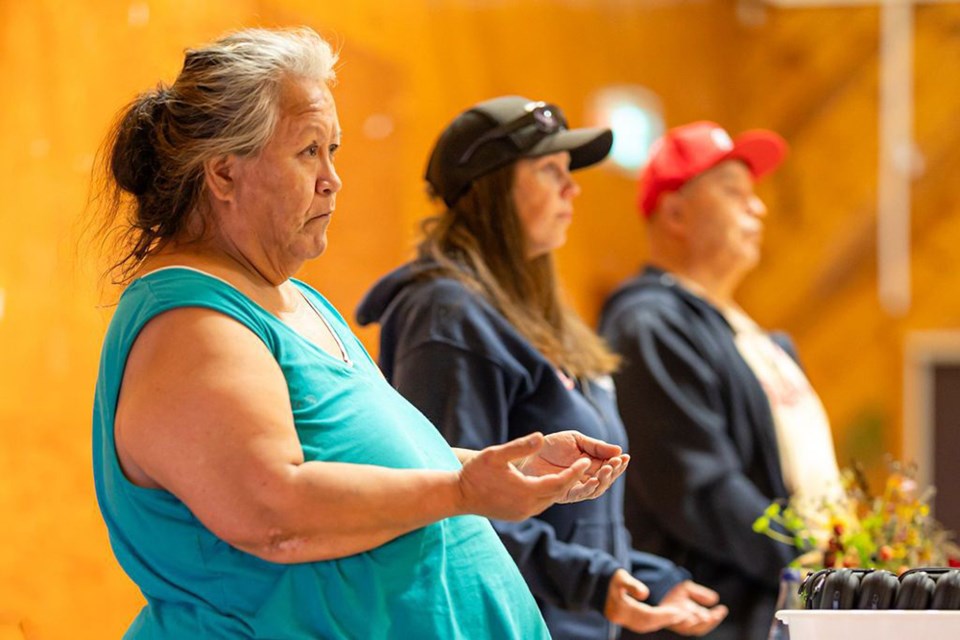ʔaǰɩmɛt means a beautiful, safe place to go. It is also the name of a unique Tla’amin-led harm reduction program that is catching provincial attention.
Housed in the renewed clubhouse by the soccer field, the ʔaǰɩmɛt harm reduction circle offers cultural programming, food, safe use supplies, drug checking services, health care referrals and more. The program was born during Tla’amin’s COVID-19 shelter in place order in September 2020. At the time, Tla’amin partnered with Lift Community Services to bring harm reduction supplies and services to the community so members could stay safe at home.
The late Kevin Blaney was also a big part of ʔaǰɩmɛt’s creation. He advocated tirelessly for better services for Tla’amin people who used substances recognizing that mainstream interventions in the toxic drug poisoning crisis were largely ineffective for First Nations.
The made-in-Tla’amin ʔaǰɩmɛt program has grown exponentially over the last three years. It is home to the first drug-checking Fourier-transform infrared (FTIR) spectrometer and drug-checking service to be located on First Nation community lands.
What is a FTIR spectrometer?
Fourier-transform infrared (FTIR) spectrometers can identify up to six substances in a drug sample. Examples include heroin, cocaine, methamphetamine, MDMA, fentanyl, benzodiazepines and various cutting agents.
FTIR spectroscopy works by shining infrared light at a sample and measuring how that light is absorbed. Drugs and cutting agents have unique absorption patterns that are then identifiable by a trained technician.
Since the ʔaǰɩmɛt program’s establishment, the number of accidental poisonings (overdoses) and their severity have gone down. The drug-checking program may have a lot to do with that. Since its inception in April 2023 there has not been one toxic poisoning fatality in the qathet region. This is critical because qathet remains one of the communities most impacted by toxic drug poisoning outside of the Downtown Eastside in Vancouver.
Tla’amin Health director Marlane Paul said the ʔaǰɩmɛt program couldn’t have happened without leadership support. The donation of the clubhouse to the program was a turning point.
“Having a dedicated space where people who use substances feel safe and welcome is a cornerstone of this program,” said Paul. “It’s a self-determined space. The clients of the program decide what it's used for and are responsible for its care.”
According to Paul, many members who have been hesitant to come to the Tla’amin Health building are accessing a range of health and social services through ʔaǰɩmɛt and she added that ownership over the space has been a contributing factor to the increased service utilization.
Courtney Harrop is the Tla’amin Nation harm-reduction coordinator. Harrop brings more than 15 years of experience in harm reduction work to the role. She says ʔaǰɩmɛt is different than mainstream harm reduction services.
“It is community-based, Indigenous-led, and incorporates Tla’amin language, culture and ways of being into all aspects of our programming and services,” said Harrop. “The relationship building and trust that develops with the people we support is a grounding aspect of the work and opens up new possibilities for collaboration and inclusion of people who use substances in all we do.”
The program’s philosophy is simple. Listening to people who use substances to design caring and community-led programming that reduces the harm from toxic drugs.
The ʔaǰɩmɛt harm reduction circle employs four persons with lived or living experience (PWLLE) who do community outreach with Tla’amin members who use substances, including alcohol.
PWLLEs providing peer support create an ongoing, caring, human and cultural connection, safer use supplies and a range of other help including food support, connection to health services, and program design and development.
Delana George works as a PWLLE and said that while her job is different every day, the bottom line is looking after a person’s whole being.
“When a person walks through that door, you can see the heaviness in their heart,” said George. “So, to be able to come to a place where they will not be judged, or called down, where they can sit across the table from someone who has been in their position and share a meal, you know it’s so important and it builds trust.”
George said the PWLLE role is important in breaking down trust barriers between members and service providers and keeping lines of communication open. She added that once the wall has come down, PWLLEs are able to offer life-saving services. The PWLLE team is contacted at all hours for safe-use-supplies kits, naloxone kits, and even to broach family reconnection.
George said that while there is a long way to go yet, the program is having a positive impact.
“The doors are open and people we work with are feeling loved and cared for,” added George. When people are treated with respect, their gifts can come out and we all deserve that.”
Drug poisonings
In 2016, death by toxic drug poisoning surpassed all other forms of death by unnatural causes in BC, including motor vehicle accident and suicide.
The dramatic increase in deaths by toxic drug poisoning in the province was officially declared a public health state of emergency on April 14, 2016. Since the declaration, more than 21,000 British Columbians have lost their lives to toxic drugs.
National Addictions Awareness Week is November 19 to 25.
Davis McKenzie is director of communications for Tla’amin Nation.
Join the Peak's email list for the top headlines right in your inbox Monday to Friday.




